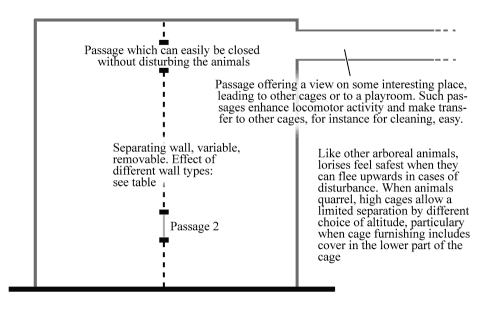
Figure: system of two adjacent cages recommended for lorises

| Minimum cage height | Minimum cage size*¹ | Minimum base | Minimum amount of branches | ||
| Fitch-Snyder et al., in preparation | 2.5 m | 16 m³ | 6.25 m² | 2.5 x 2.5 m | |
| Recommended minimum (Bochum University) | 2-2.5 m | For Loris: 2,5 m³ *² | 1 m² | 1 x 1 m | 15 m *³ |
| Official German guideline for mammals, 1996 | 2 m | 1,5 m³ | 1 x 0.75 m |
*¹ As lorises do not jump, only the parts of cage furnished by branches can be used. Empty space which is not available for the animals therefore should not be considered when cage size is judged.
*² (Cage size only sufficient in connection with very good cage furnishing and some behavioural enrichment, for instance free access to a separate play room at times and / or passages allowing running and looking outside the cage.
*3
including several m of horizontal branches, firmly attached, in
the upper
part of the cage
Effect
of separating
cage elements on the behaviour of adult slender lorises of
equal and
of opposite sex, unfamiliar to each other (Data based on routine
observation,
additional tests of 30 minutes duration and limb measurements of
dead animals).
| Separation by wall type: | Behaviour observed when a conspecific is noticed behind the wall: | Possible risks |
| Solid wall, no optical contact | Influence by acoustic stimuli. Some evidence of effects of olfactory stimuli | No risk caused by the wall. Territorial whistles of neighbours may cause aggressive behaviour |
| Solid wall with narrow clefts, no optical contact, but smell of neighbours perceivable through clefts | Sniffing at clefts and attempts to push the hands through clefts have occured. In rare cases, aggressive behaviour on both sides of a cleft occurred when neighbours noticed the smell and noise of such attempts. | If clefts are broad enough, a hand may be pushed though and bitten. One animal got trapped, unable to pull its hand back, and lost a finger because of repeated bites by neighbours. |
| Glass | Initially confusion, signs of social stress or not, sniffing at the edge of the glass. As an exception, initial low intensity threat occurred. In the long run: some interest in activities of neighbours on the other side of the glass, but no signs of agonistic behaviour. | No risk by agonistic behaviour known. In one case, an animal initially tried to bridge over to branches behind the glass, hit the glass, almost fell down and showed signs of distress and confusion for several minutes afterwards. |
| (Mirror: own image instead of conspecific) |
Signs of social stress or
not, curiosity.
No aggressive behaviour observed. |
No risk known |
| Wiremesh allowing both optical and olfactory contact: | Fierce defense of the territory against adults of the same sex may occur. Pushing against or through the wire with the hand(s) as an aggressive threat, attacks, territorial whistling, attempts to bite the opponent“s hands. | Fighting against neighbours and agonistic / territorial vocalization may cause aggression within groups in all cages. Danger of lesions: see further below. |
|
Single layer of fine
wire-mesh, mesh size
less than 3 mm
|
Fierce agonistic behaviour, social stress; no bite wounds. | |
|
Single layer of wire-mesh,
mesh size 3
mm or more
|
Animals may cling to the wiremesh while fiercely attacking each other if mesh width is larger than finger diameter (see figure) | Heavily bleeding bite wounds inflicted to fingers and toes |
|
Single layer of wire-mesh,
mesh size 1
cm x 1.5 cm or more
|
Bite wounds; hands pushed through the meshes may be seized and repeatedly bitten by the inhabitants of the next cage. In larger meshes (2.5 x 2.5 cm), animals may jam themselves; see figure. | |
|
2 wiremesh layers, 2 cm
apart.
|
Fine wiremesh: no lesions. Coarse wiremesh: the hand or arm may be pushed through (see figure) and bitten by the inhabitants of the next cage. | |
|
2 wiremesh layers, 20 cm
apart
|
No problems observed in the colony at Ruhr-University. In animals not habituated to the presence of many conspecifics, reactions might be different. | ? |
In general, observation shows that a combination of olfactory and optical stimuli from nearby conspecifics may lead to severe aggressive behaviour whereas similar perception of other species including humans has no such effect. Therefore, if an animal behaves friendly towards the keeper, this does not allow any conclusion about friendliness towards conspecifics. This must be considered when potential mates are introduced to each other: initial tests with a safe double wiremesh wall may help to avoid trouble. Smell alone or agonistic vocalization apparently can cause some aggression, but with a limited effect, optical stimuli alone apparently cause little or no aggression.
| Conservation database for lorises (Loris,
Nycticebus)
and pottos (Arctocebus, Perodicticus),
prosimian primates
Slender loris husbandry information, H. Schulze, Ruhr-University Bochum |
Last amendment: 24 February 2001
|